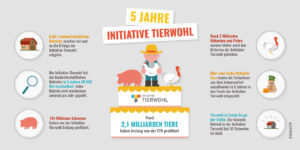The press contact of the Initiative Tierwohl – Dr. Patrick Klein – was kind enough to give me an insight into this important and for me new topic, thank you for that.
Animal welfare should concern us all, because every meat consumer should attach importance to the fact that the farm animals that he later finds on his plate as chops, poultry goulash or even salami were treated with respect. Only a species-appropriate and healthy rearing can conjure a high-quality and tasty roast onto our plates.
The Initiative Tierwohl has so far been financed by a fund model of donors from the food retailing financed – this will change in the future according to the press conference (more about the financing will certainly be available soon on the Initiative’s website).
One of the aims of the initiative is to ensure that every end consumer in the supermarket can be sure, through the animal welfare label on the packaging, that the farm animals have been kept and reared under animal welfare standards. In order to make this possible, all participating livestock producers and fatteners will receive funds per kilo of meat from animal welfare-friendly rearing, which should make it easier to fulfil all requirements and criteria.
This avoids significant surcharges on the final consumer price and customers can therefore more easily decide in favour of meat that is fair to animal welfare when purchasing, as it is hardly more expensive. This in turn supports the entire chain of farm animal meat produced and sold in compliance with animal welfare, and in the long term this will also increase its share on the shelves of our supermarkets.
The catalogue of criteria developed by the initiative currently applies to pigs and poultry and prescribes to all participating production companies the standards in which the farm animals are to be kept. This concerns, for example, the space that each animal has available during rearing, the fact that the animals must receive natural daylight or the climate in the stables. More details on the criteria can be found on the website of the Animal Welfare Initiative under criteria descriptions.
The participating farms are checked twice a year to ensure that they meet the animal welfare criteria – once with and once without announcement. If the criteria have been violated, any money received in advance must also be returned to the initiative. As far as reported, such cases are rather the exception, because the model is based on insight out of responsibility and rewards animal welfare fair breeding & husbandry with additional funds – thus a win/win/win situation for livestock producers, trade and end consumers.
From the point of view of organic producers, there is certainly more that can be achieved, but this can only work if the end consumer is willing and able to pay significantly more for meat and poultry. If the Animal Welfare Initiative can gradually ensure that in future the lowest common denominator in the meat and poultry industry is animal welfare, the shelves in our supermarkets should soon be empty of meat that was produced under dubious rearing conditions. So even if more could be done, this is already a positive step in the right direction. Above all, it leads to more personal responsibility and new insights for all those involved and, due to the approach, also achieves a high level of penetration in all areas – from production and trade to the processing companies.


